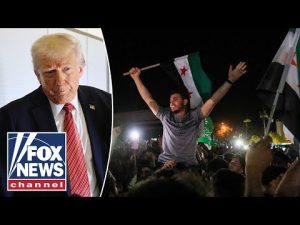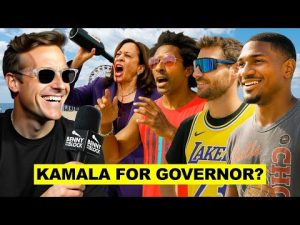**The Media Circus: Trump’s Bold Move to Keep Air Force One Clear of Certain Journalists**
In a move that has sent shockwaves through mainstream media outlets, President Trump has made headlines yet again by banning well-known news agencies like Reuters, Bloomberg, and the Associated Press from traveling with him on Air Force One during his much-anticipated trip to the Middle East. Critics have rushed to accuse Trump of trying to stifle freedom of the press, claiming he wants to sidestep accountability and silence dissent. But those familiar with the situation—or at least willing to dig a little deeper—might just uncover a more complex story.
It seems this ban isn’t merely an impulsive decision by the President to eliminate the media’s scrutiny. There’s a laundry list of concerns about the relationship between these news organizations and government entities. Some argue Reuters and AP have operated as mouthpieces for various intelligence agencies since the late 1940s, implying a deeper alliance than most are aware of. This isn’t just some wild conspiracy theory; it was a topic once scrutinized during the 1976 Frank Church hearings, which exposed the troubling intersection between media and government propaganda, known as Operation Mockingbird.
The mainstream media has undoubtedly taken a whack at Trump’s decision, framing it as an attack on freedom. However, supporters of Trump argue that it’s a mere act of self-preservation. If you look closely, it’s clear that this move aligns with Trump’s repeated claims of “fake news” and a concerted narrative that’s aimed at undermining his presidency. These outlets, having received millions in funding to promote specific government agendas during the previous administrations, have used their platforms to misrepresent key facts about the administration’s policies—especially during the COVID-19 pandemic.
Among the chaos, Trump is seen as taking a more pronounced stance against what he sees as a coordinated effort to manipulate information. While he has engaged in numerous press conferences, some see the decision to exclude specific journalists from Air Force One as a tactical measure—one meant to thwart any potential distortion of his message before it even reaches the public. If this means keeping dubious journalists at arm’s length, many supporters cheer him on, believing the media plays a dangerous game by not representing the facts or the people accurately.
Skeptics of Trump’s ban might question the feasibility of this strategy. Staying ahead of the narrative is difficult, especially when it involves managing a hefty media machine eager to spin stories. But, as many Trump supporters have suggested, allowing agencies that they associate with misinformation to travel alongside him might only lead to his words being twisted, misquoted, or taken out of context. By effectively sidelining these players, Trump seems determined to maintain the integrity of his message.
With the media landscape already rife with challenges—fueled by accusations of bias and conflicts of interest—Trump’s decision presents a timely opportunity for discussions about the role and responsibility of journalism in a democratic society. Is it censorship or a necessary precaution? Whichever side you lean towards, one thing is clear: the media circus tent is only getting bigger, and the ringmaster isn’t ready to step off the spotlight just yet.
As the dust settles from this bold move, it will be interesting to see how the media responds and what implications this ban may have for the future of presidential coverage. In an age where truth often seems to compete with entertainment, Trump’s Air Force One antics might just be the wake-up call the journalistic world didn’t know it needed.







